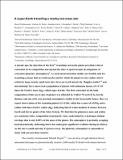A super-Earth transiting a nearby low-mass star
Author(s)
Charbonneau, David; Berta-Thompson, Zach; Irwin, Jonathan M.; Burke, Christopher J.; Nutzman, Philip; Buchhave, Lars A.; Lovis, Christophe; Bonfils, Xavier; Latham, David W.; Udry, Stephane; Murray-Clay, Ruth A.; Holman, Matthew J.; Winn, Joshua Nathan; Queloz, Didier; Pepe, Francesco; Mayor, Michel; Delfosse, Xavier; Forveille, Thierry; ... Show more Show less
DownloadWinn_A super-Earth.pdf (657.0Kb)
OPEN_ACCESS_POLICY
Open Access Policy
Creative Commons Attribution-Noncommercial-Share Alike
Terms of use
Metadata
Show full item recordAbstract
A decade ago, the detection of the first1, 2 transiting extrasolar planet provided a direct constraint on its composition and opened the door to spectroscopic investigations of extrasolar planetary atmospheres3. Because such characterization studies are feasible only for transiting systems that are both nearby and for which the planet-to-star radius ratio is relatively large, nearby small stars have been surveyed intensively. Doppler studies4, 5, 6 and microlensing7 have uncovered a population of planets with minimum masses of 1.9–10 times the Earth’s mass (Mcircle plus), called super-Earths. The first constraint on the bulk composition of this novel class of planets was afforded by CoRoT-7b (refs 8, 9), but the distance and size of its star preclude atmospheric studies in the foreseeable future. Here we report observations of the transiting planet GJ 1214b, which has a mass of 6.55Mcircle plus and a radius 2.68 times Earth’s radius (Rcircle plus), indicating that it is intermediate in stature between Earth and the ice giants of the Solar System. We find that the planetary mass and radius are consistent with a composition of primarily water enshrouded by a hydrogen–helium envelope that is only 0.05% of the mass of the planet. The atmosphere is probably escaping hydrodynamically, indicating that it has undergone significant evolution during its history. The star is small and only 13 parsecs away, so the planetary atmosphere is amenable to study with current observatories.
Date issued
2009-12Department
Massachusetts Institute of Technology. Department of Physics; MIT Kavli Institute for Astrophysics and Space ResearchJournal
Nature
Publisher
Nature Publishing Group
Citation
Charbonneau, David et al. “A super-Earth Transiting a Nearby Low-mass Star.” Nature 462.7275 (2009): 891–894. Web.
Version: Author's final manuscript
ISSN
0028-0836
1476-4687